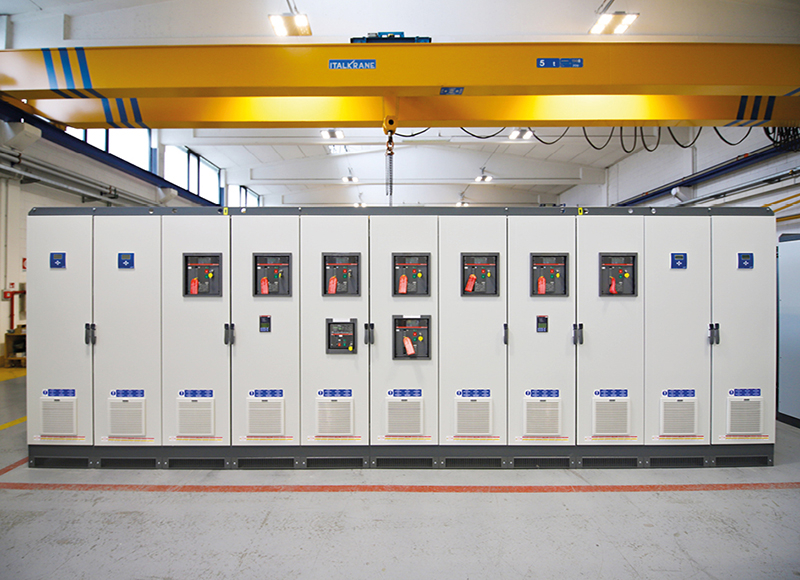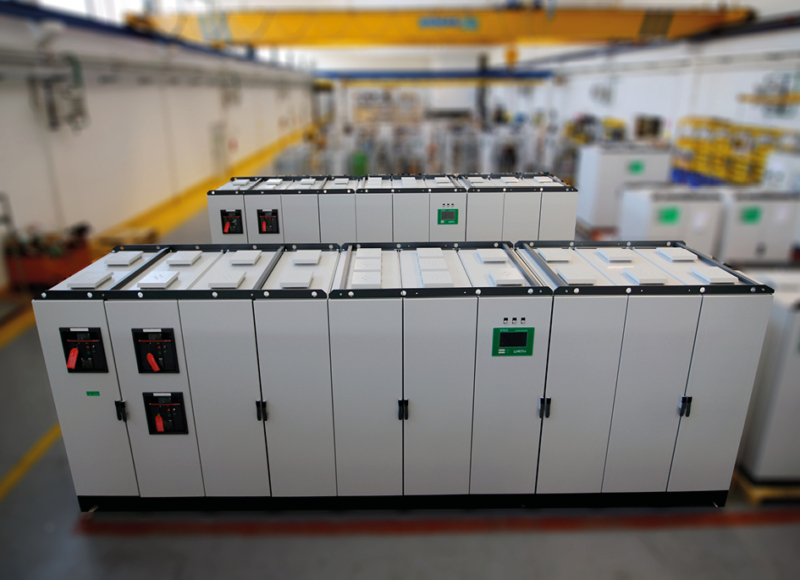THE ISSUE
The electricity produced in power plants is circulated through the electricity transmission and distribution networks and it is supplied/delivered to consumers; the quality of electricity (known as «Power Quality») is one of the important factors that determine the economic efficiency of both consumers and electrical networks.
Electrical devices are designed to work in distributing systems defined by set nominal values in terms of voltage and frequency (for example, 400V at 50Hz).
In actual fact, electric energy distribution might not ensure the stability of said nominal parameters. Voltage in particular can vary even considerably in relation to the nominal value. These variation can cause undesired and potentially dangerous conditions for the users. Voltage “fluctuations’ can be ‘fast’ and wa ste themselves away in a few milliseconds (for example, distribution lines hit by lightning) or ‘slow’, with duration that can last several seconds, minutes or even hours depending on the cause.
Slow fluctuations can be generated by increased voltage level (‘surge’ due to poor MV regulation at distribution level, disconnection of large loads, overvoltage at generators output, etc) or – more frequently – by decreased voltage level (‘sags’ due to connection of large loads, motor startup, undersized distribution lines, faults to ground, poor MV voltage regulation, etc).
In case of voltage variation, the voltage stabiliser is the solution that guarantees for the best cost/benefit ratio.
THE SOLUTION
The voltage stabiliser has proven to be an effective solution able to prevent potentially dangerous situations created by input voltage instability.
- Typical situations where voltage can be subject to fluctuation beyond the admitted tolerance are:
- Loads supplied by weak or undersized distributing lines (rural areas or locations supplied by long distributing lines such as breeding farms, tourist resorts, hotels, etc).
- Users located near distributing station and therefore subject to voltage increase.
- Private premises with high power installations (swimming pool pumps, big chillers, special lighting systems, lifts) and/or particularly voltage sensitive loads (high power consumer electronics, etc.).
- Loads located near large industrial plants where individual high power devices (MV motors) can induce voltage reduction at startup.
- Island operating loads (ships, offshore rigs, loads not connected to the public grid).
In comparison to other types of equipment, the voltage stabilser offers a number of advantages that very often make it the optimum solution:
- Usually lower price.
- High output voltage stability guaranteed even for wide input fluctuation.
- Absence of introduced harmonic distortion.
- Robust and reliable construction, allowing for use in hard environments.
- Overload capability up to twice the rated current (max 2 mins).
- No concerns in terms of storage, transportation, maintenance and disposal due to the fact that batteries are not used.
- Smooth and reliable regulation of the load voltage ensuring a ±0.5% accuracy even with important input voltage variation.
- High efficiency.
- High inrush current withstand capability.
- Reduced dimension, simple to run, ‘plug&play’ operating mode.
ELECTROMECHANICAL OR STATIC VOLTAGE STABILISERS?
The static stabiliser is used when the correction speed represents the critical issue.
The static stabilisers (to use, for example, for computers, laboratory equipment, measuring benches and medical instrumentation) has correction time of 3 milliseconds for full regulation as compared to electro-mechanical stabilizer correction time of 10-50 milliseconds (depends on the model) per volt.
CRITERIA FOR CHOOSING THE RIGHT TYPE
Number of phases
The number of phases of a stabiliser depends on the type of load:
- single-phase load: single-phase stabiliser;
- combination of several single-phase loads on the same line: three-phase stabiliser or a single-phase stabiliser on each load;
- three-phase load: three-phase stabiliser.
Rated voltage
Due to the fact that the nominal voltage varies internationally, establish the rated voltage required at the stabiliser input and output. In case of three-phase systems, provide with the line-to-line voltage value. The standard voltage stabiliser can operate with nominal voltage 380V-400V-415V (50Hz) or 440V-460V-480V (60Hz).
Input variation range
It’s key information for the choice and the design of the stabiliser. Establish the amplitude of the oscillation of the input voltage and always keep a safety margin on such percentage: for example, if the measured fluctuation is ±16%, then choose a stabiliser suitable for ±20% variation. Note: if the input variation exceeds the nominal one, the difference is added to the output precision. For example, if a stabiliser designed for ±15% input variation receives a +20% voltage, the output precision shall not be ±0.5% but ±5.5%.
Type of regulation
The three-phase voltage stabilisers perform an independent regulation on each phase. The connection to the distributing line neutral wire is mandatory. Should the neutral wire not be available, a specific accessory component must be added.
Type of technology
In most applications, the electromechanical voltage stabiliser is a reliable and safe tool. In case of high regulation speed is required (milliseconds), it is better to choose the solution with regulation by means of IGBT static switches.
Rated power
All the stabilisers are designed for the maximum input current, but it is advisable to consider an extra safety margin for possible future expansions. In a voltage stabiliser, the power is expressed in kVA, whilst the load power is usually expressed in kW. Remember that the link between these two measuring units is provided by the power factor (cos φ): kVA = kW / cos φ. Also, remember that if the power factor and/or the load power in kW cannot be easily established, me asure the absorbed currents in order to allow for a correct design of the stabiliser and keeping in mind that:
- kVA (1-ph.) = load voltage x load current.
- kVA (3-ph.) = root of 3 x phase to phase load voltage x load current.
Installation
Choose the other characteristics of the stabiliser considering the installation conditions. The following aspect must be known:
- IP protection degree required.
- Indoor or outdoor installation.
- Site altitude and climatic characteristics.
- Ambient temperature.
- Possible environmental hazards such as aggressive atmosphere, exposure to chemical components and so on.
Accessories
A standard voltage stabiliser can be enriched with a number of accessories:
- Interruption and protection devices.
- Load protection against over/undervoltage.
- Bypass line.
- Input isolating transformer.
- Total protection kit.
- Surge arrestor (SPD).
- Integrated automatic power factor correction system.
- EMI/RFI filter.
- Neutral point reactor.
- Up to IP54/55 protection degree for both indoor and outdoor installation.
Special construction
By means of some modifications, it is possible to obtain special stabilisers able to:
- deal with asymmetrical input voltage variation different from the standard range (for example, from -55% to +20% of the nominal voltage);
- deliver an output voltage different from the input one (for example, Vin = 400V ±15%, Vout = 460V ±0.5%).
DESIGN CRITERIA
A voltage stabiliser is a power device destined to be positioned between the mains and the User.
The purpose is to ensure that the User is fed a voltage subject to a variation much lower (±0.5% with regards to the nominal value) that the one guaranteed by the distributing system.
The stabilization is performed on the “true rms” voltage and it is not affected by harmonics in the mains. Due to the fact that the regulation does not involve any intervention on the sinewave, neither an appreciable harmonic distortion nor a phase displacement is introduced on the downstream line.
The stabiliser is not affected by the load power factor (cos φ) and can operate with a load percentage varying between % and 100% on each phase. Regulation speed depends on the input voltage variation percentage and on the type of construction. Indicatively, said speed ranges between 8 and 30millisec/V.
Basically, a voltage stabiliser is made of a buck/boost transformer, a voltage regulator and an electronic control. Based on a microprocessor that samples at high frequency the output voltage, the control system drives the regulator gearmotor. By doing so, the regulator rollers change their position and therefore the voltage drawn and supplied to the buck/boost transformer primary winding. Being the secondary voltage of the buck/boost transformer in phase or in opposition to the supply, the voltage drawn from the regulator is added or subtracted to the mains voltage, thus compensating its variations.
The voltage regulator is nothing but an autotransformer with continuously variable transformer ratio. Depending on the stabiliser power, the regulator can be either toroidal or columnar.
CONCLUSIONS
The continuous availability of stable voltage supply independently from input fluctuation is very often a key feature to ensure efficiency and reliability for the User. Reduced productivity, data loss, security failure, machine faults, inaccurate information and domestic inconveniences are only a few examples of potential problems caused by unsteady supply. Obviously, all that results in higher managing cost.







